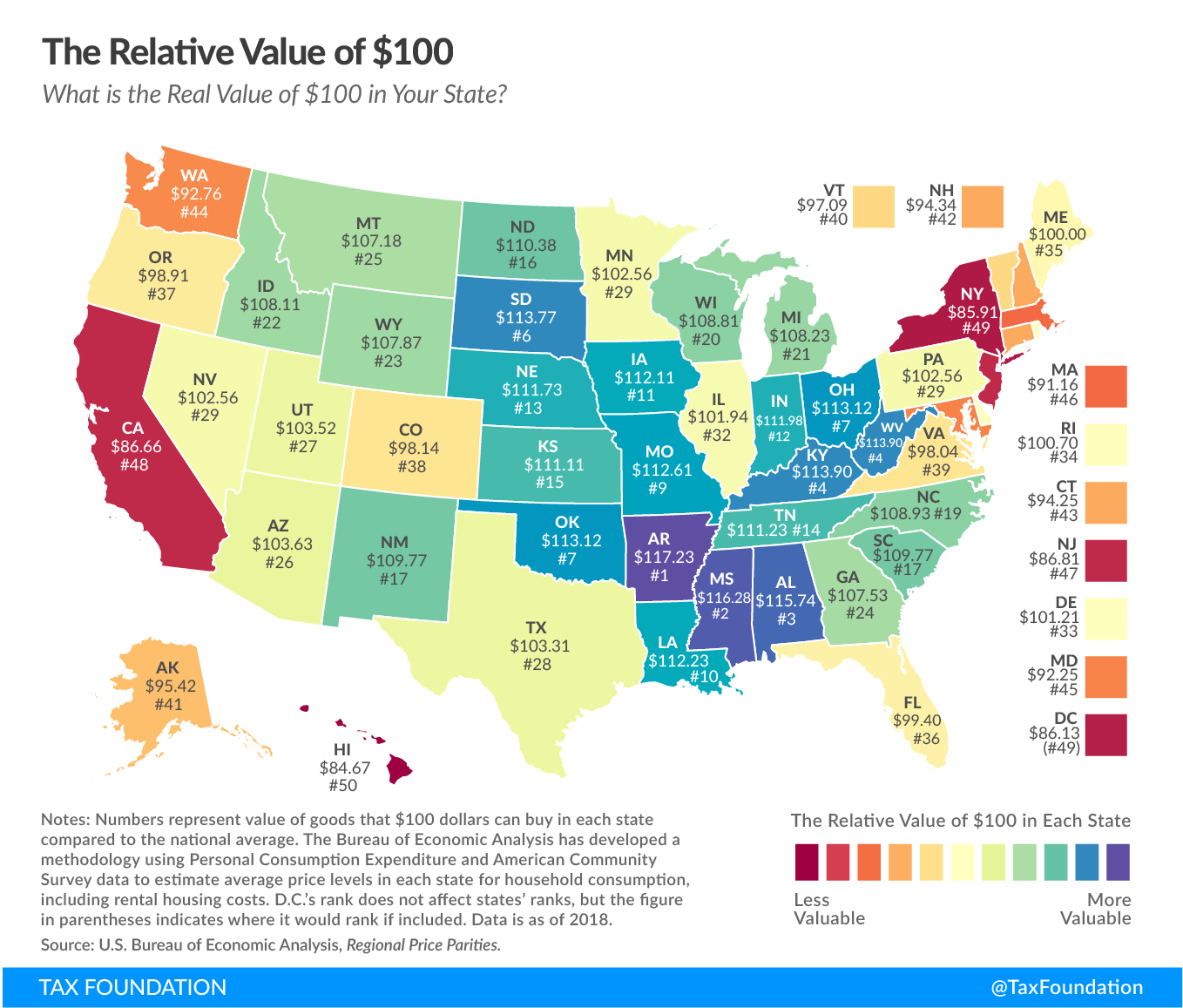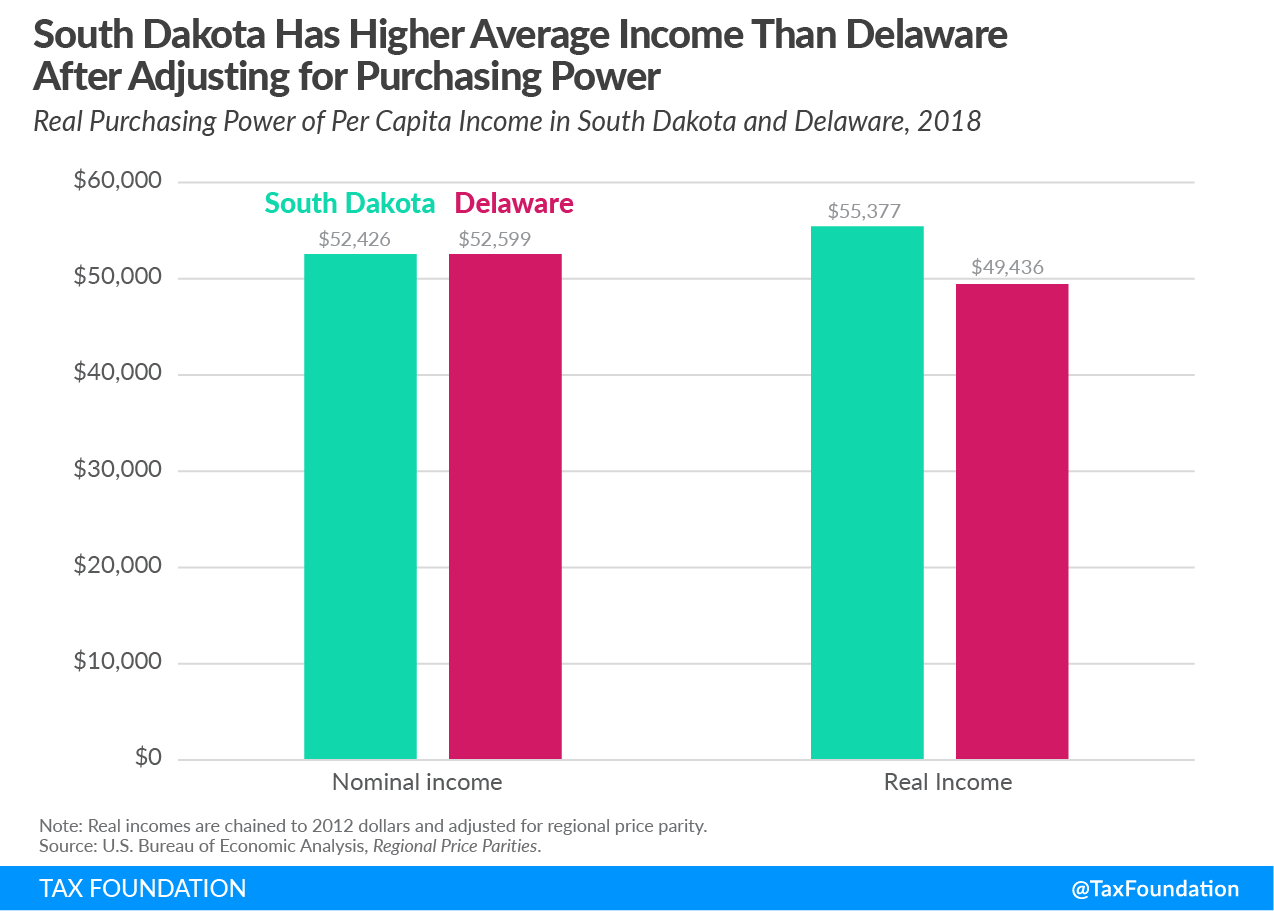This map shows the real value of $100 in each state. Across the United States, the cost of living fluctuates, as prices for the same goods may be cheaper in some areas—such as rural parts of Arkansas or South Dakota—than in large cities in states like New York or California. This means that the same amount of money can buy comparatively more in a low-price state than a high-price state.
The U.S. Bureau of Economic Analysis (BEA) measures real personal income by state and metropolitan area each year. The latest estimates are for prices in 2018, which can be used to show the value of $100 (how much it buys you in every state).
NEW: What is the relative value of $100 in your metropolitan area?
In this map, $100 represents the amount of goods and services that can be bought in a state with average national prices. In states with higher-than-average prices, such as Vermont, $100 will buy comparatively less than a state with lower-than-average prices, such as Tennessee. We illustrate this by adjusting the $100 national average for each state.
For example, Ohio is a low-price state. There, $100 will buy goods and services that would cost $113.12 in a state at the national average price level. Put another way, Ohioans are, on average, about 13 percent richer than their nominal incomes suggest.
The states where $100 is worth the most are Arkansas ($117.23), Mississippi ($116.28), Alabama ($115.74), Kentucky ($113.90), and West Virginia ($113.90). On the other hand, $100 is effectively worth the least in Hawaii ($84.67), New York ($85.91), the District of Columbia ($86.13), California ($86.66), and New Jersey ($86.81). See the table below for a ranking of all 50 states.
There are large regional differences in prices across the United States. For example, real purchasing power is more than 35 percent greater in Arkansas than it is in California. This means that, on average, someone earning $50,000 in after-tax income in Arkansas would need after-tax earnings of about $67,500 in California to maintain the same standard of living.
Generally speaking, states with higher nominal incomes also have higher price levels. This is because areas with higher incomes tend to see the prices of finite resources like land rise as they are bid up. Areas with higher costs of living also tend to pay higher salaries for identical jobs, which offsets at least some of the lower average purchasing power.
While states with higher nominal incomes tend to have higher prices, this is not always the case. Some states, like North Carolina, have higher-than-average incomes without corresponding higher-than-average prices. That is why it is important to adjust incomes for different price levels, as it can change our perceptions of the standard of living for each state.
For example, residents of South Dakota and Delaware earn about the same amount of nominal dollars per capita, but after adjusting for regional price parity, those in South Dakota can buy more.
This has large implications for policy, as many policies such as minimum wage levels, tax brackets, and means-tested public benefit income thresholds are denominated in nominal dollars. Because each state has a different price level, these amounts are not equivalent in purchasing power, making it an important consideration when policymakers consider reforms to state and federal taxes and spending.
| State | Relative Value of $100 | Rank |
|---|---|---|
| Arkansas | $117.23 | 1 |
| Mississippi | $116.28 | 2 |
| Alabama | $115.74 | 3 |
| West Virginia | $113.90 | 4 |
| Kentucky | $113.90 | 4 |
| South Dakota | $113.77 | 6 |
| Oklahoma | $113.12 | 7 |
| Ohio | $113.12 | 7 |
| Missouri | $112.61 | 9 |
| Louisiana | $112.23 | 10 |
| Iowa | $112.11 | 11 |
| Indiana | $111.98 | 12 |
| Nebraska | $111.73 | 13 |
| Tennessee | $111.23 | 14 |
| Kansas | $111.11 | 15 |
| North Dakota | $110.38 | 16 |
| South Carolina | $109.77 | 17 |
| New Mexico | $109.77 | 17 |
| North Carolina | $108.93 | 19 |
| Wisconsin | $108.81 | 20 |
| Michigan | $108.23 | 21 |
| Idaho | $108.11 | 22 |
| Wyoming | $107.87 | 23 |
| Georgia | $107.53 | 24 |
| Montana | $107.18 | 25 |
| Arizona | $103.63 | 26 |
| Utah | $103.52 | 27 |
| Texas | $103.31 | 28 |
| Nevada | $102.56 | 29 |
| Minnesota | $102.56 | 29 |
| Pennsylvania | $102.56 | 29 |
| Illinois | $101.94 | 32 |
| Delaware | $101.21 | 33 |
| Rhode Island | $100.70 | 34 |
| Maine | $100.00 | 35 |
| Florida | $99.40 | 36 |
| Oregon | $98.91 | 37 |
| Colorado | $98.14 | 38 |
| Virginia | $98.04 | 39 |
| Vermont | $97.09 | 40 |
| Alaska | $95.42 | 41 |
| New Hampshire | $94.34 | 42 |
| Connecticut | $94.25 | 43 |
| Washington | $92.76 | 44 |
| Maryland | $92.25 | 45 |
| Massachusetts | $91.16 | 46 |
| New Jersey | $86.81 | 47 |
| California | $86.66 | 48 |
| District of Columbia | $86.13 | [49] |
| New York | $85.91 | 49 |
| Hawaii | $84.67 | 50 |
|
Source: U.S. Bureau of Economic Analysis, Regional Price Parities. Note: Washington, D.C.’s rank does not affect states’ ranks, but the figure in parentheses indicates where it would rank if included. |
||
What is the relative value of $100 in your metropolitan area?
Share this article
